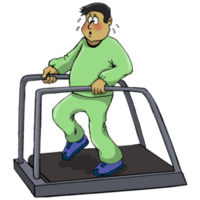Emotional Eating

A new study from Miriam Hospital’s Weight Control and Diabetes Research Center in Providence, Rhode Island, has just been published in the journal Obesity. The research suggests that dieters who tend to eat in response to external factors like parties and celebrations, have fewer problems with their weight loss than those who eat in response to internal factors such as emotions. The study also found that emotional eating was associated with weight regain in people who had successfully lost weight
The researchers analyzed individual’s responses to questions in a well-known research tool called the Eating Inventory which is designed to assess three aspects of eating behavior:
- Cognitive restraint
- Hunger
- Disinhibition
The main focus was on the third item, since some previous research has suggested that disinhibition as a whole is an accurate predictor of weight loss.
The disinhibition scale evaluates impulsive eating in response to emotional, cognitive, or social cues.
There were two groups in the study. The first consisted of 286 overweight men and women who were currently participating in a behavioral weight loss program. The second group included 3,345 members of the National Weight Control Registry (NWCR), an ongoing study of adults who have lost at least 30 pounds and kept it off for at least one year.
The investigators found that the components within the disinhibition scale could be grouped into two distinct factors: external and internal disinhibition.
An example of external disinhibition would be the person who overeats when they are with someone who is also overeating, or the person who just overeats at a party, picnic or celebration.
The person with internal disinhibition eats in response to thoughts and feelings such as loneliness, upset or anxiety.
In both groups internal disinhibition was a significant predictor of weight over time. For participants in the weight loss program, the higher the level of internal disinhibition, the less weight an individual lost over time. The same was true for maintainers in the NWCR: Internal disinhibition predicted weight regain over the first year of registry membership.
Before starting a weight management program it is very helpful to know which group you are in. It provides us with a quick and easy method of tailoring the program to the individual, and tells us where to put our efforts.
More Genes Involved in Obesity

I am impressed by the progress being made by some of my former colleagues who are busily unraveling the complex genetics of obesity.
In a paper in the journal Science a group of British scientists including Chris Ponting of the Medical Research Council Functional Genetics Unit in Oxford and Stephen O’Rahilly’s group at the University of Cambridge, has made a second breakthrough in twelve months in understanding how a gene triggers weight gain in some individuals. In May we looked at the first piece of work on the gene called “FTO.”
At that time we learned that variations in the FTO gene influence people’s risk of becoming obese. This particular gene was of great interest because the genetic variant in FTO that predisposes to obesity is very common in the population.
About half the British population carries a copy of the variant and they are on average 3-4 pounds heaver than those who do not have it. The 16 per cent of the population who carry two copies of the variant and are on average 6-7 pounds heavier. We also learned that carriers of the variant have an increased risk of diabetes. However the function of FTO was completely unknown.
The new paper shows that the FTO gene codes for an enzyme – 2-Oxoglutarate-Dependent Nucleic Acid Demethylase – that can act directly on DNA. This strongly suggests that FTO might have a role in controlling how and when genes are turned on and off.
The investigators also found that FTO is highly expressed in the hypothalamic region of the brain, which has important roles in the control of hunger and satiety. In certain areas of the hypothalamus, the levels of FTO are influenced by feeding and fasting.
This is a remarkable finding. That a gene involved in obesity and diabetes has a direct effect on DNA in specific regions of the brain is very exciting. It suggests that the gene is involved in influencing how well the brain senses hunger and fullness. Small molecules derived from metabolism can modulate the activity of FTO, so we can see a direct link form food to metabolism to DNA in the brain.
The findings raise all kinds of treatment possibilities and also confirm something that I have been teaching for three decades: weight control does not start with a diet. It starts between the ears. Until you have been shown how to re-program your brain, thoughts and emotions, your chance of successfully controlling your weight is, ahem, slim.
Television and High Blood Pressure in Overweight Children

After learning that watching too much television may cause behavior problems in children, a new report in the American Journal of Preventive Medicine indicates that watching too much television may push up a child’s blood pressure, but only if he or she is overweight.
Researchers from the University of California, San Diego; the Rady Children’s Hospital – San Diego; the University of California, San Francisco; and the University of South Alabama collected data on 546 young people, aged 4 to 17 years, who were evaluated for obesity at pediatric subspecialty weight management clinics in San Diego, San Francisco and Dayton, Ohio, from 2003 to 2005. Children and their parent(s) were given a written questionnaire, which was used to estimate the average daily time spent watching TV, and then a physician verbally reviewed and confirmed the time estimate. The height and weight of the children were measured to determine a Body Mass Index and their blood pressures were recorded.
The investigators found that TV time was positively correlated with the severity of obesity. After controlling for race, site, and BMI score, both the severity of obesity and daily TV time were significant independent predictors of the presence of hypertension. Children watching 2 to 4 hours of TV had 2.5 times the odds of hypertension compared with children watching 0 to 2 hours. The odds of hypertension for children watching 4 or more hours of TV were 3.3 times greater than for children watching less than 2 hours of TV.
Yet more evidence that as wonderful as the television can be, too much of anything is not a good idea.
Well, almost anything…
“I find television very educating. Every time somebody turns on the set I go into the other room and read a book.”
–Groucho Marx (American Comedian, 1890-1977)
The Neurology of Eating

Any attempt at weight management that fails to address the whole person is doomed to failure.
It is not enough to diet and exercise, and whatever the truth of manifesting, you cannot think yourself thin. Success demands an approach that integrates every system of your body, mind, social and subtle systems. For many people there is even an important role for integrating their spirituality into a plan for healthy living.
So we need to learn as much as we can about each component. Some fascinating new research has added some important pieces to the puzzle.
Writing in the journal Nature a group of scientists from University College London and King’s College London used peptide YY (PYY), a naturally occurring hormone that regulates appetite, to investigate which areas of the brain are involved in controlling food intake.
PYY is released into the bloodstream from the intestine after we eat something. In animals PYY signals the appetite control centers in the hypothalamus and brainstem that food has been eaten. Injections of this hormone have been shown to decrease food intake both in healthy volunteers and in people with obesity.
The hypothalamus and brainstem are ancient regions of the brain involved I te most basic functions. But humans have complex, highly developed brains, and the question was to discover how PYY regulates eating in humans.
The study involved eight normal weight men in a double blind placebo-controlled study. After 14 hours without food the subjects were given an intravenous infusion of either PYY or placebo for 100 minutes. During all this their brains were scanned continuously using functional Magnetic Resonance Imaging (fMRI). Thirty minutes later they were offered an unlimited meal. Each subject was tested twice one week apart, once with PYY and once with the placebo. PYY infusion reduced food consumption in all 8 subjects and on average caused a 25% reduction in the calories eaten.
Now it gets interesting. The fMRI scans showed that PYY not only targets the primitive parts of our brain that control feeding but it also acts in the corticolimbic brain regions that are involved in the rewarding and pleasurable aspects of eating.
The greatest change in brain activity in response to PYY was within the orbitofrontal cortex (OFC), a region that acts as an integrative center in the brain and is also implicated in reward processing. The change in OFC activity predicted how much food the volunteers subsequently ate. The greater the activation, the less people.
When we are hungry, brain activity within the hypothalamus predicts how much food we should eat. However an infusion of PYY tricks the brain into thinking that it has eaten, and switches on the circuits that control eating. The activity in the orbitofrontal cortex now predicts how much people will eat in the future.
If you have not eaten for a long time, you get full very quickly. It is not that your stomach has shrunk; it is that the production of hormones like PYY has been turned down. When you eat, they are over-produced and switch off more eating. When someone has gastric bypass surgery, their levels of PYY go up and stay up.
An important aspect of weight management is to retrain and reprogram the mind and body.
This research helps to show us how the approach works.
The Evolving Obesity Pandemic

Here is something that is not too much of a shock. At least it isn’t until you look at the numbers.
People are getting heavier throughout the world, with the possible exception of south and east Asia. These are the conclusions of a one-day global “snapshot:” a single day in 2006 when doctors and nurses in 63 countries across five continents – not even including the United States – found that between half and two-thirds of men and women in were overweight or obese.
The study is being published in the journal Circulation and included 168,159 people. The initial results were published http://eurheartjsupp.oxfordjournals.org/cgi/content/abstract/8/suppl_B/B26 last year in the European Heart Journal, but this new report puts more “flesh” on the original report.
The International Day for the Evaluation of Obesity (IDEA) study looked at two measures of fatness – waist circumference and body mass index or BMI.
A BMI (weight in kg divided by square of height in meters) of 18.5 to 25 is considered healthy. A BMI over 25 is considered overweight and greater than 30 is obese. I shall have something to say about BMI in a moment.
In Eastern Asia 7% were obese, compared with:
- 36% of people in Canada
- 38% of women in Middle Eastern countries
- 40% in South Africa
Canada and South Africa led in the percentage of overweight people, with an average BMI of 29 among both men and women in Canada and 29 among South African women.
In Northern Europe men had an average BMI of 27 and women 26. In other words they were just into the overweight “category.” In southern Europe, the average BMI was 28. In Australia BMI for men was 28 and 27.5 for women. In Latin America the average BMI was just under 28.
Waist circumference was also high – 56% of men and 71% of women carried too much weight around their middle.
The overall frequency of heart disease was 16% in men and 13% in women. In Eastern European men, many of whom still smoke, the rates of heart disease, 27%, and women, 24%. By comparison in Canada the rate of heart disease in women was 8%, and in men 16%.
The rates of diabetes varied across regions. Overall, 13% of men and 11% of women were diagnosed with diabetes.
This means that the rest of the world is catching up with the United States, long considered the country with the worst weight problem.
An estimated two-thirds of Americans are overweight and a third of these are obese. In the US, the lifetime risk of developing diabetes, is also high – 33% for men and 38% for women.
In studies like these, a BMI over 25 is considered to be overweight and greater than 30 is obese. I have commented before about the limitations of using BMI, but it remains a way of getting an overall picture of what is happening in the body.
The findings are deeply worrying.
It is well known that increasing weight, particularly the amount of fat carried inside the abdomen – not the “lovers’ handles!” – increase the risk of coronary artery disease, Type II diabetes and other diseases including some cancers. That point about the “intra-abdominal” fat I all important. For years we have been told that even small increases in weight can do us harm, but that is not completely accurate. It is where the fat is deposited, not only how much we have. It is only when people become extremely obese all over that the risks of many diseases begin to climb.
The moral of the story?
Watch you the size of your abdomen, and stay tuned as I give you more advice about the Whole Person ways to control you weight.
Exercise Beats "Dieting" in Managing Obesity

An important report was presented at the Scientific Meeting of the United Kingdom Society for Behavioural Medicine in Cambridge earlier this month.
A team of researchers from Leeds Metropolitan University and the University of Hull studied 62 women aged 24 to 55. They all had a Body Mass Index (BMI) over 30, which is classed as clinically obese. (Regular readers will know that most experts have moved away from using BMI to evaluate metabolic and cardiovascular risks).
The program encouraged women not to diet but to take part in exercise classes. They were required to do four hours a week of exercise, such as t’ai chi, aqua aerobics or circuit classes. So it was not necessary to become a hard core exercise freak!
The researchers found significant improvements in health and mental well-being.
The women in the study were also taught about good eating habits, including how to read food labels and cook food, and they received social support and behavioral therapy to help them respond to body cues such as hunger and feeling full.
After a year, the women had only lost a little weight but were significantly fitter and happier with themselves. Their blood pressure, heart rate and cholesterol fell and respiratory fitness increased. And the women also felt better in terms of general well-being, body image, self-perception and stress.
This small, simple study re-emphasizes what we have said to tens of thousands of people: fad diets will only help in the short term. For all practical purposes you can eat what you want, but in moderation. But try gradually to change the composition of your diet. I have written some advice on doing that. In Healing, Meaning and Purpose we also provide a number of tactics to help you tackle some of the psychological and social hurdles that may stand in the way of weight management. Which include something not often discussed: the twelve ego-fears that can be the hidden drivers to a lot of our behavior.
Understand them and you can gain a remarkable degree of control of your thinking and your emotions.
And it is exercise that should be the centerpiece of a weight management strategy.
This was re-inforced by a study published last week in the Archives of Internal Medicine: people who lost weight by restricting calories lost bone mineral density. Those with exercise-induced weight loss did not.
And as you doubtless know, loss of bone mineral density is one of the key risk factors for osteoporosis.
So please don’t buy in to some new “miracle” diets: they simply don’t exist.
Instead:
- Gradually increase your level of exercise
- Slowly change the composition of your diet
- Keep your internal organs – especially your intestine – in balance
- Develop your food awareness (I am going to do a whole post/article about that!)
- Learn how to deal with the psychological, social subtle and spiritual aspects of suboptimal eating (Check out the reources that I have already provided + a new eBook in the New Year)
And before you know it, you will be exactly where you want to be.
Promise!
Lack of activity destroys the good condition of every human being, while movement and methodical physical exercise save it and preserve it.”
–Plato (Athenian Philosopher, 428-348 B.C.E.)
“The way to cheerfulness is to keep our bodies in exercise and our minds at ease.”
–Sir Richard Steele (English Dramatist and Essayist, 1672-1729)
The Fad-Free Diet: Glycemic Index, Glycemic Load and Dietary Fiber

This is the time of year when a lot of us are thinking about getting rid of those extra pounds that we put on over the holidays, and perhaps thinking ahead to swimsuit season. Thus, magazines are full of articles about diet and every day there are new advertisements for different weight loss products.
For several years now, many diet plans have revolved around the notion of the glycemic index of foods, which is an estimate of the average rise in blood glucose levels after eating a certain food, or of glycemic load, a ranking system of the carbohydrate content of foods based on their glycemic index. This has always seemed to be an attractive concept that is also easy to follow. Foods that have a high glycemic index cause blood glucose to rise rapidly. As a result insulin levels rise to try and compensate, and then an array of other hormones are released to try and re-establish biochemical balance.
Insulin is a complex hormone, with over 500 recognized actions in the body. Insulin resistance is a condition in which some of the cells of the body, primarily in the liver and in adipose or fat tissue and in muscle, become unable to respond to some of the actions of insulin. It is the opposite of insulin sensitivity. As a result, insulin levels begin to rise, until ultimately the pancreas can no longer keep up with the demand. Insulin resistance is known to be a key metabolic problem associated with many illnesses, including Type 2 diabetes, hypertension, high levels of triglycerides and sometimes cholesterol, polycystic ovarian syndrome and even some types of cancer. It is typically associated with an increase in abdominal obesity, though insulin resistance may also cause obesity.
There is an important article in this month’s issue of the journal, Diabetes Care that has examined the impact of the composition of the diet on insulin sensitivity, insulin secretion and fat in a study of 979 adults enrolled in the Insulin Resistance Atherosclerosis Study. The conclusions are interesting and important: glycemic index and glycemic load were not related to measures of insulin sensitivity or secretion, or to the amount of fat in the body. However, in line with other research studies, the intake of fiber in the diet was again found to have beneficial effects on insulin sensitivity, adiposity and the secretion of insulin by the pancreas.
The conclusions once again show us the importance of increasing fiber in our diets, and indicate that the diets based on glycemic index and glycemic load are probably on their last legs.
The study follows one using the Dietary Approaches to Stop Hypertension (DASH) diet published in the December issue of Diabetes Care. A well-conducted randomized showed that the diet, which is rich in fruits, vegetables, and low-fat dairy foods, lowered blood pressure and has beneficial effects on blood lipids.
The real trick is to follow some simple strategies for following through with your resolutions (see my post on January 4th), and to follow a balanced diet and exercise program. I only wish that there were some magic fix for dealing with weight problems, but sadly there does not seem to be. Despite an enormous amount of research, and thousands of diet plans, what we have learned is that some people will do fine on almost any kind of diet, but not everyone will benefit, and some diets can be risky if they are not well-balanced. In my book Healing, Meaning and Purpose, I outline some simple dietary principles that I have used with thousands of people with great success for over 25 years. In a nutshell:
1. Energy balance is important
2. Calories do count
3. What you include in your diet is as important as what you exclude
4. Make only moderate dietary changes at any time: making big dietary changes can be a pretty violent attack on your body and your mind
5. Avoid the “trans-fatty acids”
6. Try to consume some omega-3 fatty acids
7. Eat fewer simple carbohydrates: that advice still holds, despite the new study
8. Use weight management strategies that enhance your overall health and well-being
9. Take more exercise
I don’t think that it can get much simpler than that. Though when someone interviewed me recently, and asked for a one-liner, I said: “Avoiding eating anything white, unless it is a prescription medicine.” Overly simplistic, of course, but simple watch words that have helped an awful lot of people. Good luck!
Technorati tags: Diet, Glycemic index, Insulin resistance







